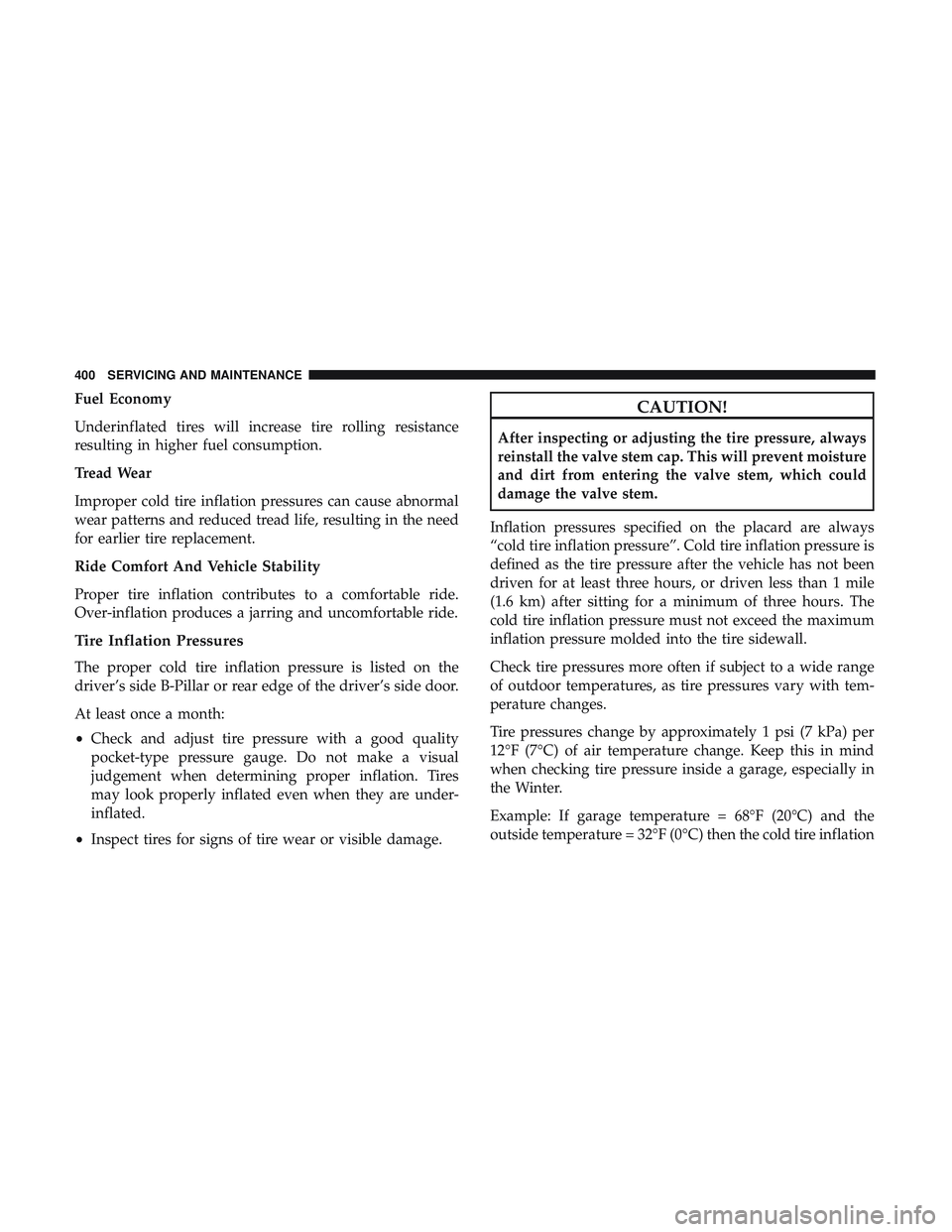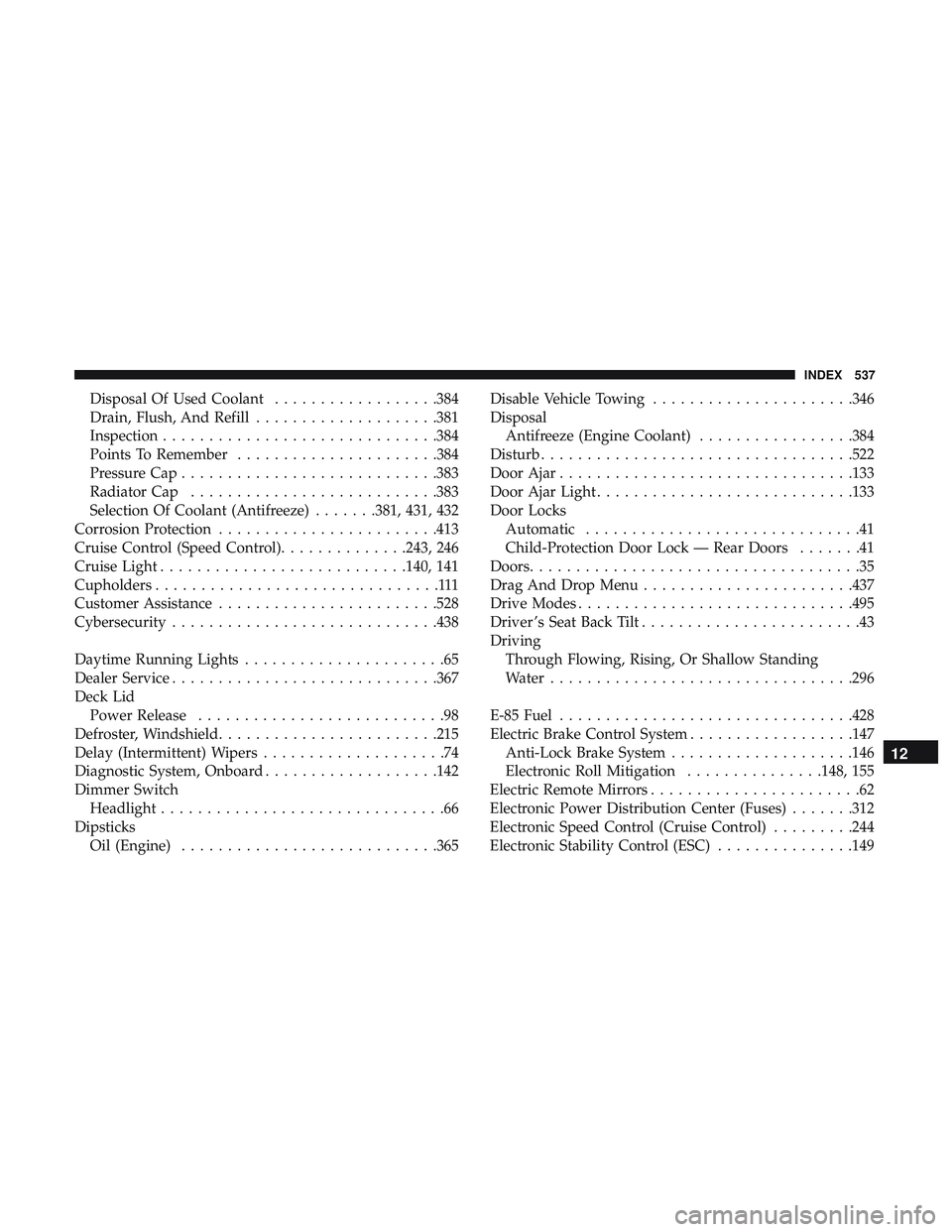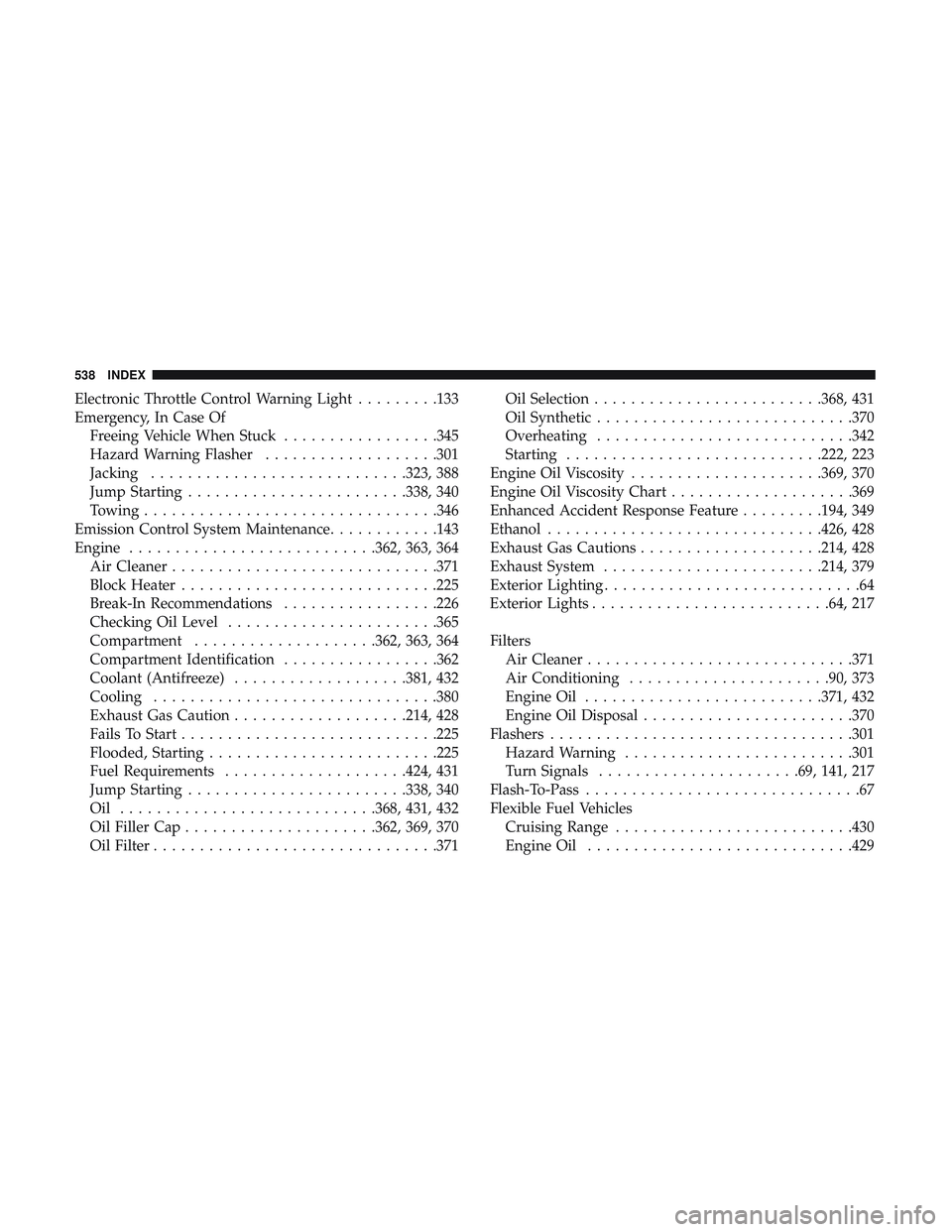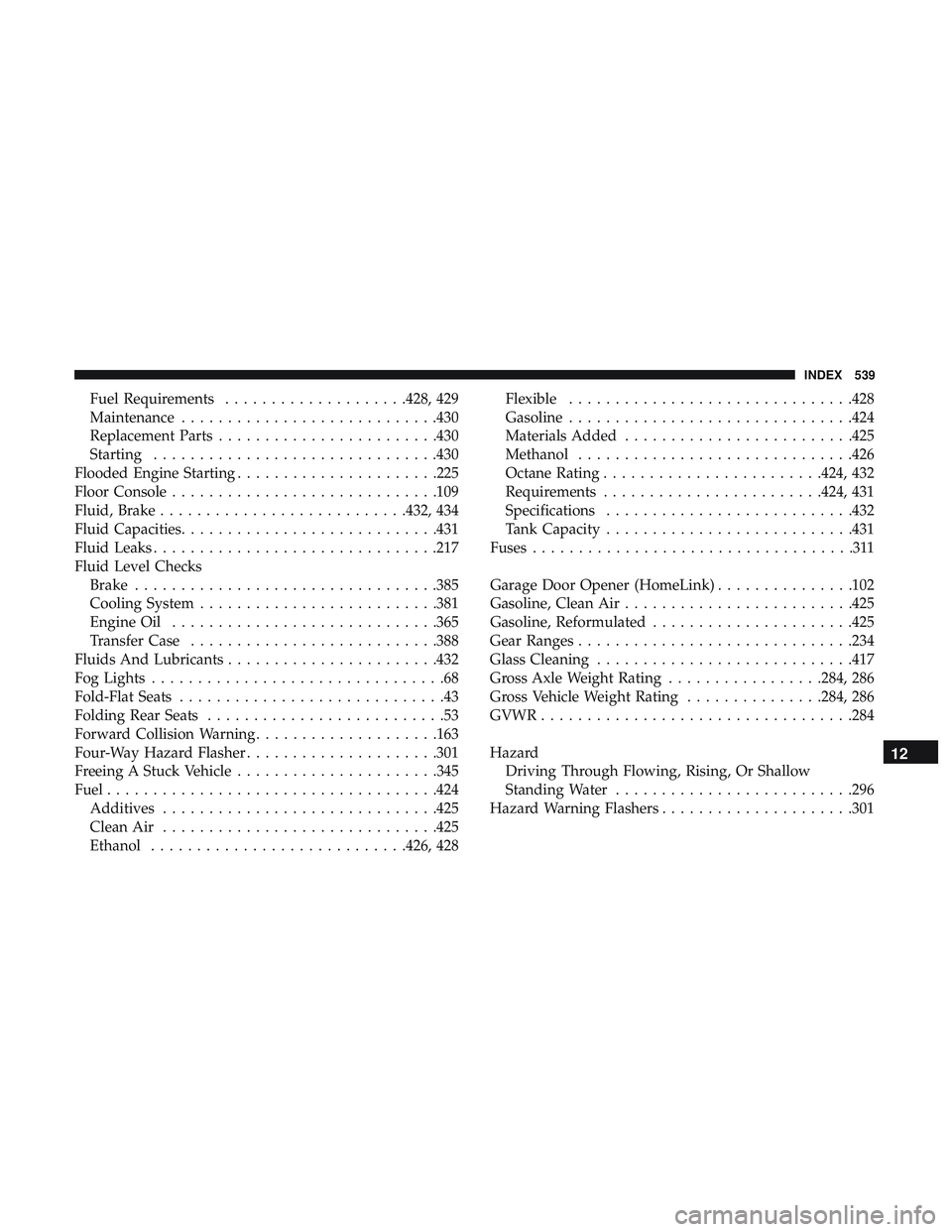2018 DODGE CHARGER fuel cap
[x] Cancel search: fuel capPage 402 of 553

Fuel Economy
Underinflated tires will increase tire rolling resistance
resulting in higher fuel consumption.
Tread Wear
Improper cold tire inflation pressures can cause abnormal
wear patterns and reduced tread life, resulting in the need
for earlier tire replacement.
Ride Comfort And Vehicle Stability
Proper tire inflation contributes to a comfortable ride.
Over-inflation produces a jarring and uncomfortable ride.
Tire Inflation Pressures
The proper cold tire inflation pressure is listed on the
driver’s side B-Pillar or rear edge of the driver’s side door.
At least once a month:
•Check and adjust tire pressure with a good quality
pocket-type pressure gauge. Do not make a visual
judgement when determining proper inflation. Tires
may look properly inflated even when they are under-
inflated.
• Inspect tires for signs of tire wear or visible damage.
CAUTION!
After inspecting or adjusting the tire pressure, always
reinstall the valve stem cap. This will prevent moisture
and dirt from entering the valve stem, which could
damage the valve stem.
Inflation pressures specified on the placard are always
“cold tire inflation pressure”. Cold tire inflation pressure is
defined as the tire pressure after the vehicle has not been
driven for at least three hours, or driven less than 1 mile
(1.6 km) after sitting for a minimum of three hours. The
cold tire inflation pressure must not exceed the maximum
inflation pressure molded into the tire sidewall.
Check tire pressures more often if subject to a wide range
of outdoor temperatures, as tire pressures vary with tem-
perature changes.
Tire pressures change by approximately 1 psi (7 kPa) per
12°F (7°C) of air temperature change. Keep this in mind
when checking tire pressure inside a garage, especially in
the Winter.
Example: If garage temperature = 68°F (20°C) and the
outside temperature = 32°F (0°C) then the cold tire inflation
400 SERVICING AND MAINTENANCE
Page 430 of 553

NOTE:Intentional tampering with the emissions control
system can result in civil penalties being assessed against
you.
Carbon Monoxide Warnings
WARNING!
Carbon monoxide (CO) in exhaust gases is deadly.
Follow the precautions below to prevent carbon mon-
oxide poisoning:
• Do not inhale exhaust gases. They contain carbon
monoxide, a colorless and odorless gas, which can
kill. Never run the engine in a closed area, such as a
garage, and never sit in a parked vehicle with the
engine running for an extended period. If the vehicle
is stopped in an open area with the engine running
for more than a short period, adjust the ventilation
system to force fresh, outside air into the vehicle.
• Guard against carbon monoxide with proper main-
tenance. Have the exhaust system inspected every
time the vehicle is raised. Have any abnormal condi-
tions repaired promptly. Until repaired, drive with
all side windows fully open.
FLEXIBLE FUEL (3.6L ENGINE ONLY)
E-85 General Information
The information in this section is unique for Flexible Fuel
vehicles only. These vehicles can be identified by a unique
fuel filler door label that states Ethanol (E-85) or Unleaded
Gasoline Only and/or a yellow fuel cap. Please refer to the
other sections of this manual for information on features
that are common between Flexible Fuel and non-Flexible
Fuel powered vehicles.
CAUTION!
Only vehicles with the E-85 fuel filler door label or a
yellow gas cap can operate on E-85.
Ethanol Fuel (E-85)
E-85 is a mixture of approximately 85% ethanol and 15%
unleaded gasoline.
428 TECHNICAL SPECIFICATIONS
Page 431 of 553

WARNING!
Ethanol vapors are extremely flammable and could
cause serious personal injury. Never have any smoking
materials lit or products that can cause spark in or near
the vehicle when removing the fuel filler tube cap (gas
cap) or filling the tank. Do not use E-85 as a cleaning
agent and never use it near an open flame.
Fuel Requirements
If your vehicle is E-85 compatible, it will operate on
unleaded gasoline with any octane rating greater than 87
(R+M)/2, or solely E-85 fuel, or any mixture of these fuels.
For best results, avoid fueling patterns alternating be-
tween E-85 and unleaded gasoline.
When switching fuel types:
•Add 5 gallons (19 liters) or more when refueling.
• Drive the vehicle immediately after refueling for at least
5 miles (8 km).
Observing these precautions will avoid possible hard start-
ing and/or driveability problems during warm up. NOTE:
•
Use seasonally adjusted E-85 fuel (ASTM D5798). With
non-seasonally adjusted E-85 fuel, hard starting and
rough idle following start up may be experienced even if
the above recommendations are followed, especially
when the ambient temperature is below 32°F (0°C).
• Some additives used in regular gasoline are not fully
compatible with E-85 and may form deposits in your
engine. To eliminate driveability issues that may be
caused by these deposits, a supplemental gasoline addi-
tive, such as Mopar Injector Cleanup or Techron may be
used.
Selection Of Engine Oil For Flexible Fuel Vehicles
(E-85) And Gasoline Vehicles
FFV vehicles operated on E-85 require specially formulated
engine oils. These special requirements are included in
Mopar engine oils, and in equivalent oils meeting FCA US
Material Standard MS-6395. It is recommended that engine
oils that are API Certified and meet the requirements of
Material Standard MS-6395 be used. MS-6395 contains
additional requirements, developed during extensive fleet
testing, to provide additional protection to FCA US LLC
engines.
9
TECHNICAL SPECIFICATIONS 429
Page 433 of 553

FLUID CAPACITIES
U.S.Metric
Fuel (Approximate)
3.6L Engine (87 Octane, 0-15% Ethanol or up to 85% Ethanol for Flex Fuel (E-85) En-
gine) 18.5 Gallons 70 Liters
5.7L Engine (89 Octane Recommended – 87 Octane Acceptable, 0-15% Ethanol) 18.5 Gallons 70 Liters
6.4L Engine (91 Octane or higher, 0-15% Ethanol) 18.5 Gallons 70 Liters
Engine Oil With Filter
3.6L Engine (SAE 5W-20, API Certified) 6 Quarts 5.6 Liters
5.7L Engine (SAE 5W-20, API Certified) 7 Quarts 6.6 Liters
6.4L Engine (SAE 0W-40, Synthetic API Certified) 7 Quarts 6.6 Liters
Cooling System*
3.6L Engine (Mopar Antifreeze/Engine Coolant 10 Year/150,000 Mile (240,000 km)
Formula or equivalent) 10 Quarts 9.5 Liters
5.7L Engine – without Severe Duty II Cooling System (Mopar Antifreeze/Engine
Coolant 10 Year/150,000 Mile (240,000 km) Formula or equivalent) 14.5 Quarts 13.9 Liters
5.7L Engine – with Severe Duty II Cooling System (Mopar Antifreeze/Engine Cool-
ant 10 Year/150,000 Mile (240,000 km) Formula or equivalent) 15 Quarts 14.3 Liters
6.4L Engine (Mopar Antifreeze/Engine Coolant (OAT coolant conforming to
MS.90032) 10 Year/150,000 Mile (240,000 km) Formula or equivalent) 15.2 Quarts 14.4 Liters
* Includes heater and coolant recovery bottle filled to MAX level.
9
TECHNICAL SPECIFICATIONS 431
Page 434 of 553

FLUIDS AND LUBRICANTS
Engine
ComponentFluid, Lubricant, or Genuine Part
Engine Coolant We recommend you use Mopar Antifreeze/Coolant 10 Year/150,000 Mile
Formula OAT (Organic Additive Technology).
Engine Oil – 3.6L/5.7L Engine We recommend you use API Certified SAE 5W-20 Engine Oil, meeting the requirements of FCA Material Standard MS-6395 such as Mopar, Pennzoil,
and Shell Helix Ultra. Refer to your engine oil filler cap for correct SAE
grade.
Engine Oil – 6.4L Engine For best performance and maximum protection under all types of operating
conditions, the manufacturer only recommends full synthetic engine oils.
The manufacturer recommends the use of Pennzoil Ultra Platinum 0W-40 or
equivalent Mopar engine oil meeting the requirements of FCA Material Stan-
dard MS-12633 for use in all operating temperatures
Engine Oil Filter We recommend you use a Mopar Engine Oil Filter.
Spark Plugs We recommend you use Mopar Spark Plugs.
Fuel Selection – 3.6L Engine 87 Octane, 0-15% Ethanol.
Fuel Selection – 3.6L Flex Fuel (E-85)
Engine 87 Octane, Up to 85% Ethanol.
Fuel Selection – 5.7L Engine 89 Octane Recommended – 87 Octane Acceptable, 0-15% Ethanol.
Fuel Selection – 6.4L Engine 91 Octane or higher, 0-15% Ethanol.
432 TECHNICAL SPECIFICATIONS
Page 539 of 553

Disposal Of Used Coolant..................384
Drain, Flush, And Refill ....................381
Inspection ............................. .384
Points To Remember ..................... .384
Pressure Cap ............................383
Radiator Cap .......................... .383
Selection Of Coolant (Antifreeze) .......381, 431, 432
Corrosion Protection ........................413
Cruise Control (Speed Control) ..............243, 246
Cruise Light .......................... .140, 141
Cupholders ...............................111
Customer Assistance ........................528
Cybersecurity ............................ .438
Daytime Running Lights ......................65
Dealer Service ............................ .367
Deck Lid Power Release ...........................98
Defroster, Windshield ........................215
Delay (Intermittent) Wipers ....................74
Diagnostic System, Onboard ...................142
Dimmer Switch Headlight ...............................66
Dipsticks Oil (Engine) ............................365 Disable Vehicle Towing
..................... .346
Disposal Antifreeze (Engine Coolant) .................384
Disturb ................................. .522
Door Ajar ............................... .133
Door Ajar Light ............................133
Door Locks Automatic ..............................41
Child-Protection Door Lock — Rear Doors .......41
Doors ....................................35
Drag And Drop Menu .......................437
Drive Modes ............................. .495
Driver ’s Seat Back Tilt ........................43
Driving Through Flowing, Rising, Or Shallow Standing
Water .................................296
E-85 Fuel ............................... .428
Electric Brake Control System ..................147
Anti-Lock Brake
System ....................146
Electronic Roll Mitigation ...............148, 155
Electric Remote Mirrors .......................62
Electronic Power Distribution Center (Fuses) .......312
Electronic Speed Control (Cruise Control) .........244
Electronic Stability Control (ESC) ...............149
12
INDEX 537
Page 540 of 553

Electronic Throttle Control Warning Light.........133
Emergency, In Case Of Freeing Vehicle When Stuck .................345
Hazard Warning Flasher ...................301
Jacking ............................323, 388
Jump Starting ........................338, 340
Towing ............................... .346
Emission Control System Maintenance ............143
Engine .......................... .362, 363, 364
Air Cleaner ............................ .371
Block Heater ............................225
Break-In Recommendations .................226
Checking Oil Level .......................365
Compartment ....................362, 363, 364
Compartment Identification .................362
Coolant (Antifreeze) ...................381, 432
Cooling ...............................380
Exhaust Gas Caution ...................214, 428
Fails To Start ............................225
Flooded, Starting ........................ .225
Fuel Requirements ....................424, 431
Jump Starting ........................338, 340
Oil ............................368, 431, 432
Oil Filler Cap .....................362, 369, 370
Oil Filter ...............................371 Oil Selection
........................ .368, 431
Oil Synthetic ............................370
Overheating ............................342
Starting ............................222, 223
Engine Oil Viscosity .....................369, 370
Engine Oil Viscosity Chart ....................369
Enhanced Accident Response Feature .........194, 349
Ethanol ............................. .426, 428
Exhaust Gas Cautions ....................214, 428
Exhaust System ........................214, 379
Exterior Lighting............................
64
Exterior Lights ..........................64, 217
Filters Air Cleaner ............................ .371
Air Conditioning ..................... .90, 373
Engine Oil ..........................371, 432
Engine Oil Disposal .......................370
Flashers .................................301
Hazard Warning ........................ .301
Turn Signals ..................... .69, 141, 217
Flash-To-Pass ..............................67
Flexible Fuel Vehicles Cruising Range ..........................430
Engine Oil ............................ .429
538 INDEX
Page 541 of 553

Fuel Requirements....................428, 429
Maintenance ............................430
Replacement Parts ........................430
Starting ...............................430
Flooded Engine Starting ..................... .225
Floor Console ............................ .109
Fluid, Brake .......................... .432, 434
Fluid Capacities ............................431
Fluid Leaks ...............................217
Fluid Level Checks Brake .................................385
Cooling System ..........................381
Engine Oil ............................ .365
Transfer Case .......................... .388
Fluids And Lubricants .......................432
Fog Lights ................................68
Fold-Flat Seats .............................43
Folding Rear Seats ..........................53
Forward Collision Warning ....................163
Four-Way Hazard Flasher .....................301
Freeing A Stuck Vehicle ..................... .345
Fuel ................................... .424
Additives ............................. .425
Clean Air ............................. .425
Ethanol ............................426, 428 Flexible
...............................428
Gasoline ...............................424
Materials Added ........................ .425
Methanol ............................. .426
Octane Rating ........................424, 432
Requirements ........................424, 431
Specifications .......................... .432
Tank Capacity .......................... .431
Fuses ...................................311
Garage Door Opener (HomeLink) ...............102
Gasoline, Clean Air ........................ .425
Gasoline, Reformulated ..................... .425
Gear
Ranges ............................. .234
Glass Cleaning ............................417
Gross Axle Weight Rating .................284, 286
Gross Vehicle Weight Rating ...............284, 286
GVWR ................................. .284
Hazard Driving Through Flowing, Rising, Or Shallow
Standing Water ..........................296
Hazard Warning Flashers .....................301
12
INDEX 539